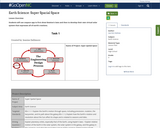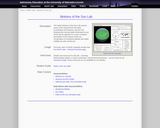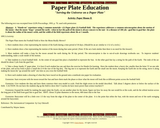
Students will use a model of the solar system to demonstrate the barycenter that exists between the earth and the sun.
- Subject:
- Earth Science
- Science
- Material Type:
- Activity/Lab
- Author:
- William Allred
- Carrie Robledo
- Date Added:
- 05/19/2021

Students will use a model of the solar system to demonstrate the barycenter that exists between the earth and the sun.

Students will use a model of the solar system to demonstrate rotation, revolution, kepler’s laws, Newton's laws, precession, nutation, seasons or tides.

In this activity, the principle of moments is applied to rotating systems to demonstrate the concept of a barycenter, or center of mass, and how objects in orbit around each other move. Students then consolidate this concept by calculating the centre of mass in a number of astronomical contexts.

This lesson will help students visualize barycenter and the relationship between the sun and the earth. Students will use a solar system model to demonstrate barycenter and see the effects of adding other planets into the mix.

In this unit, students will learn about Kepler's three laws. Students will also learn about the orbits of satellites and how to mathematically represent satellite motion. Lessons in this unit include: Kepler's Three Laws; Circular Motion Principles for Satellites; Mathematics of Satellite Motion; Weightlessness in Orbit; and Energy Relationships for Satellites. This unit includes animations and mini quizzes to check for understanding and facilitate learning.

Students will use a collection of Hubble Space Telescope images of galaxies in the Coma Cluster to study classification and the evolution of galaxies.

Students will use cospace app to first show Newton’s laws and then to develop their own virtual solar system that expresses all of earth’s motions.

Students will construct 2 ellipses, and examine and measure them to determine some of the fundamental properties of ellipses.

This resource is a compilation of text and other elements that serves as a multimedia learning experience for students. The resource reviews gravity and how it affects our solar system.

This interactive allows the user to explore Kepler's first law.

This interactive allows students to explore Kepler's 2nd law, using the speed of the planets.

In this interactive lesson, students will learn what "retrograde" and "opposition" means in astronomy while modeling this phenomenon.

These notes outline Kepler's three laws of planetary motion. Diagrams are used to supplement the explanation of the first two laws, and sample calculations are given in support of the third law.

Students review Kepler's three laws of planetary motion, defining the parts of an ellipse and describing the calculation of the eccentricity of an ellipse and associated orbital path. In an associated hands-on activity "Constructing Orbits," students will model orbits using string and calculate the eccentricities of the orbits they construct.

Students will use an elliptical board to obtain speed and distance measurements for an object in an elliptical orbit. The results are then plotted on a graph of speed against time in order to understand how gravity effects (or changes) the speed of a planet or a satellite in an elliptical orbit.

The NAAP Motions of the Sun Lab reviews some of the material from the Basic Coordinates and Seasons Lab and The Rotating Sky Lab and adds information to put all the pieces together for a more complete description of the motions of the sun. Computation of meridional altitude and stellar visibility are also introduced.

Students will study the properties of ellipses, use a formula to measure the eccentricity of an ellipse, state Kepler's Law of Elliptical Orbits. They will also predict the solar energy received at different positions in a planet's orbit.

Students will use a paper plate and a football field to address a common misconception about the motion of the moon - that the moon "loops" around the earth - when in fact the path of the moon is always concave to the sun. At a distance of 100 yards - goal line to goal line - the plate is about the radius of the moon's orbit, and the width of the field represents about 30 degrees or 1 month. In an extension activity, students can investigate barycenter.

Students will use a model of the solar system to demonstrate rotation, revolution, Kepler’s laws, Newton's laws, precession, nutation, seasons or tides. They will use kapwing.com to create their own stop motion video.

This interactive helps students practice identifying Terrestrial and Jovian planets.